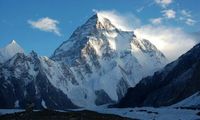The formidable slopes of K2, the world’s second-highest mountain, have once again claimed the life of a determined climber, underscoring the ever-present dangers that haunt even the most experienced adventurers in Pakistan’s northern peaks. Chinese mountaineer Guan Jing, 37, died on August 12, 2025, after being struck by falling rocks while descending from the summit she had successfully reached just a day earlier, according to Dawn and other local outlets.
Guan’s fatal accident occurred on the notorious Abruzzi Spur route, specifically between Camp-I and the Advanced Base Camp—an area infamous among mountaineers for its frequent rockfalls and unpredictable hazards. The route, while popular, is regarded as one of the most treacherous stretches on K2, a mountain that towers at 8,611 meters and is widely considered more dangerous than even Mount Everest. According to Karrar Haidri, senior vice president of the Alpine Club of Pakistan, Guan died from a head injury caused by the falling rocks. “Her loss is deeply tragic,” Haidri expressed, extending condolences to her family, friends, and the international mountaineering community (Dawn).
Recovery efforts for Guan’s body were hampered by the region’s volatile weather—another constant threat for those who dare the Karakoram. Initially, a team of fellow mountaineers attempted to reach her on foot, but persistent bad weather grounded helicopter operations. Eventually, Army Aviation was able to deploy a helicopter from Concordia, locating her body 100–150 meters above the Advanced Base Camp at an altitude of approximately 5,400 meters. Her remains were transported to Skardu, where they are now held at the Combined Military Hospital, pending repatriation to China. Pakistani officials have already contacted the Chinese authorities in Islamabad to facilitate this process (Associated Press).
Guan Jing’s tragic end is not an isolated incident on K2 this climbing season. Only days earlier, Pakistani mountaineer Muhammad Iftikhar Hussain lost his life after an avalanche struck his group during another K2 expedition. The avalanche hit four climbers in total; three foreign nationals sustained minor injuries and were swiftly evacuated to a nearby hospital, while Hussain could not be saved. His body was returned to Skardu and will be laid to rest in his hometown of Sadpara village (Minute Mirror).
The dangers of the Karakoram are well known to those who venture there. Avalanches, rockfalls, sudden and severe weather changes—these are just some of the perils climbers face. In fact, the fatality rate on K2 is significantly higher than that of Everest, a chilling statistic that deters none but the most resolute adventurers. Yet, the allure of these peaks remains undiminished. Each season, from May to September, hundreds of climbers from around the world flock to Gilgit-Baltistan, eager to test their limits against nature’s most formidable obstacles (Associated Press).
Despite the recent spate of deaths, Pakistani authorities have not imposed new warnings or restrictions on mountaineering expeditions in the region. Faizullah Faraq, spokesperson for the government of Gilgit-Baltistan, emphasized that climbers are fully aware of the risks posed by the region’s weather and terrain. “Despite that, they willingly accept these challenges and come here to attempt these summits,” Faraq told the Associated Press. He added that mountaineering expeditions are a vital part of the local economy, supporting countless families for an entire year with the earnings from a single season. “A large number of people work on these expeditions, feeding their families for the whole year with these earnings,” he said.
The economic impact of these expeditions is considerable. Not only do they bring in millions of dollars in direct revenue, but they also provide seasonal employment for guides, porters, and support staff. The government is keenly aware of this, and Faraq noted that efforts are underway to enhance infrastructure, rescue capacity, and safety measures for climbers. “Authorities are trying to provide climbers with better infrastructure, rescue facilities, security and a friendly environment,” Faraq said (Associated Press).
Yet, the risks are not limited to the mountains themselves. This year, heavier-than-normal monsoon rains have battered Gilgit-Baltistan, triggering flash floods and landslides that further endanger both climbers and local residents. The region, which lies in the disputed Kashmir territory, is no stranger to natural disasters, but the 2025 season has been particularly challenging. In August of the previous year, two Russian climbers were stranded for six days before being rescued, a reminder of how quickly fortunes can change on these peaks (Associated Press).
International tragedies have not been confined to K2. Several weeks before Guan Jing’s death, German Olympic gold medalist and climber Laura Dahlmeier perished while attempting to summit Laila Peak in the Karakoram range. Her family, respecting her wishes, declined a recovery operation—she had reportedly stated that no one should risk their life to retrieve her body should tragedy strike. This highlights a somber reality: the remains of climbers are typically recovered only at the request of their families; if not, they are left where they fell (Associated Press).
Despite these sobering events, the draw of the Karakoram remains as strong as ever. The mountains, with their breathtaking beauty and unforgiving terrain, continue to attract climbers from across the globe. For many, the risks are part of the appeal—a test of skill, endurance, and sheer willpower. But for the families and communities left behind, each loss is a painful reminder of the price that sometimes must be paid.
As the 2025 climbing season continues, the government’s commitment to improving safety and rescue operations will be tested. The balance between economic necessity, local livelihoods, and the imperative to protect lives—both of climbers and those who support them—remains delicate. For now, the mountains stand silent, bearing witness to both human triumph and tragedy, as they have for generations.
Guan Jing’s final climb serves as a poignant reminder of the risks that define high-altitude mountaineering in Pakistan. Her legacy, like that of so many before her, is etched into the rugged slopes of K2—a testament to the enduring allure and peril of the world’s most dangerous peaks.





